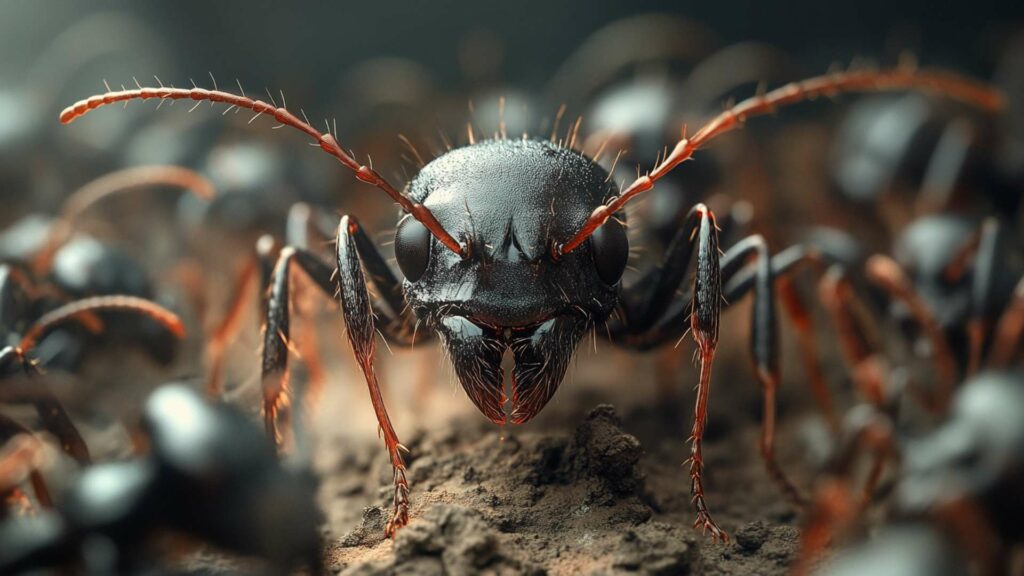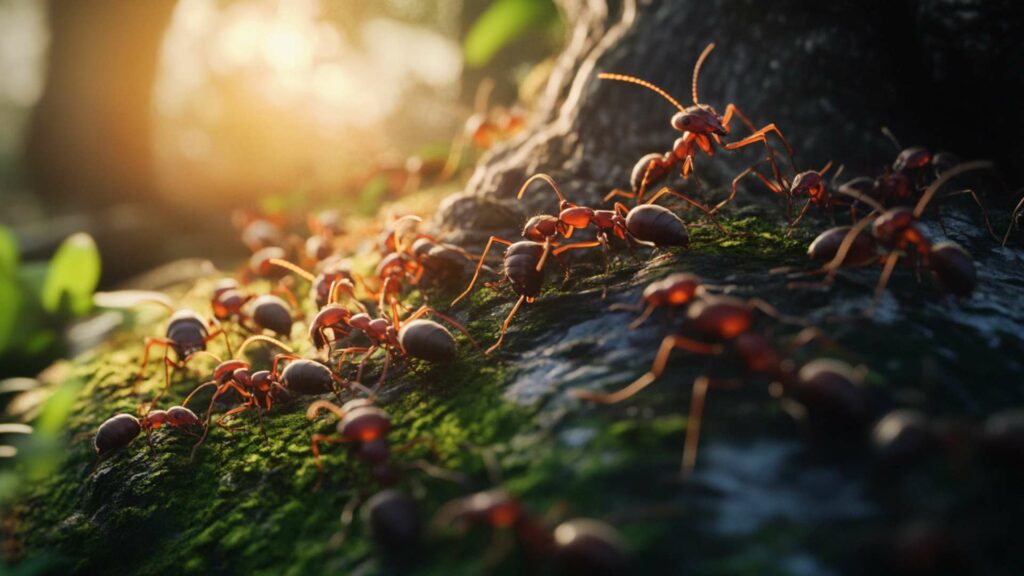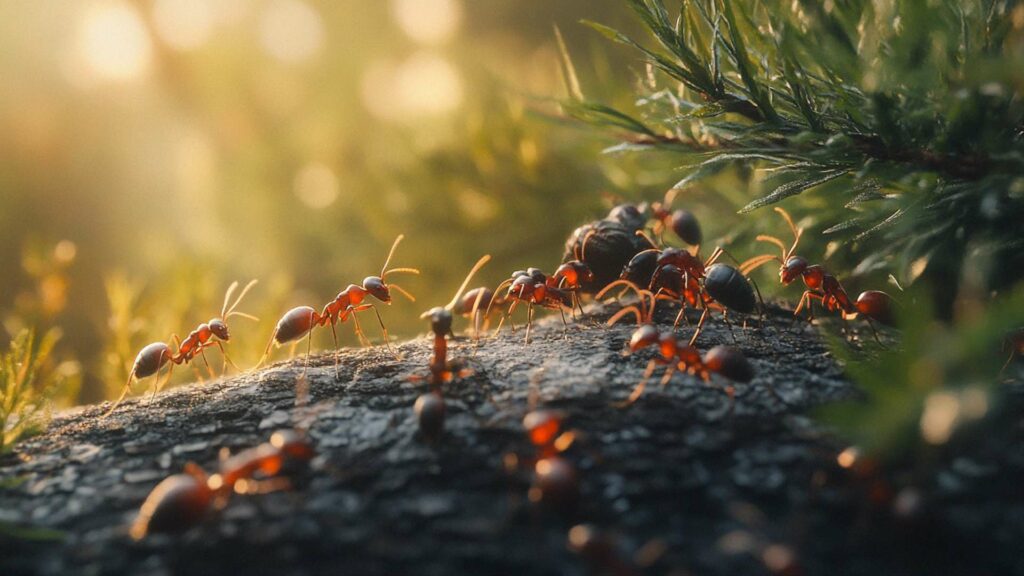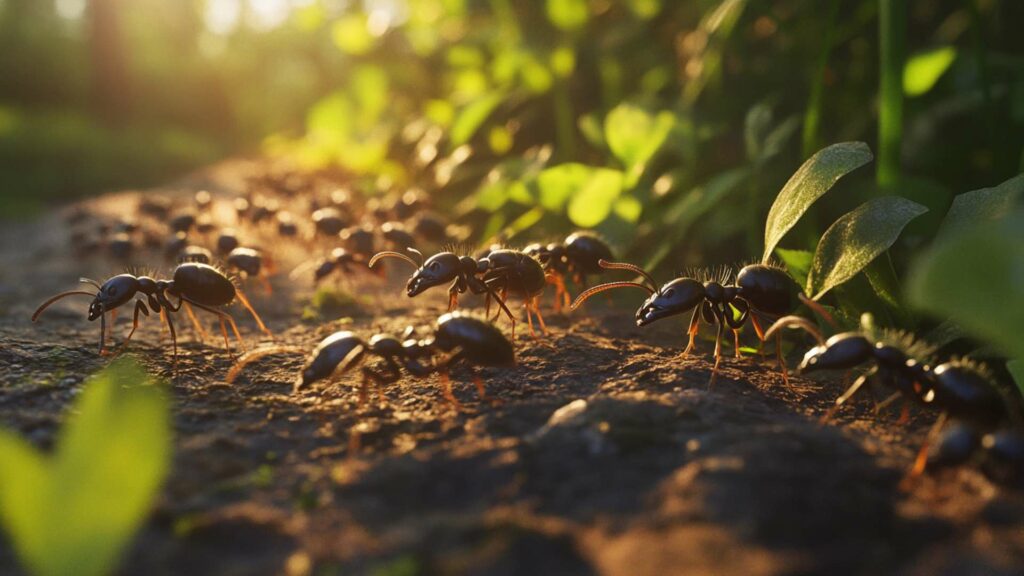Diatomaceous earth, often referred to as DE, is a naturally occurring sedimentary rock that is formed from the fossilized remains of microscopic algae called diatoms. These algae have hard exoskeletons made of silica, which accumulate over time in ancient bodies of water such as lakes and oceans. When these deposits are mined and refined, they yield the fine powder known as diatomaceous earth.
The composition of diatomaceous earth is primarily silica, with traces of other minerals such as calcium, magnesium, and iron. It is this high silica content that gives DE its unique properties and makes it effective for various applications.
Common Uses and Benefits of Diatomaceous Earth

Diatomaceous earth has a wide range of uses due to its versatile nature. One of its most common applications is as an insecticide or pest control agent. DE works by absorbing lipids from the exoskeletons of insects like ants, causing them to dehydrate and ultimately die.
This method offers a natural alternative to chemical pesticides without harming humans or pets. Aside from pest control purposes, diatomaceous earth has numerous other benefits.
It can be used in gardening to improve soil structure and retain moisture. Additionally, DE has absorbent qualities that make it useful for spill cleanup or odor control in litter boxes or pet areas.
Furthermore, diatomaceous earth finds applications outside the realm of pest control and gardening. It can be used in filtration systems to purify water or filter swimming pools due to its ability to trap particles efficiently.
Overall, diatomaceous earth’s versatility makes it a valuable substance for various industries ranging from agriculture to household maintenance. Its natural composition combined with its eco-friendly properties makes it an attractive choice for those seeking safer alternatives for pest control without compromising efficacy.
Understanding Ants and their Behavior

An Army of Tiny Invaders
Ants, those industrious six-legged creatures, have infiltrated homes across the globe, persistently seeking food and shelter. While there are numerous ant species that can become unwelcome guests in our humble abodes, a few notorious ones tend to dominate household infestations.
These include the opportunistic Argentine ants (Linepithema humile), pesky Pavement ants (Tetramorium caespitum), and the fiery Red imported fire ants (Solenopsis invicta). Each species brings its unique set of habits and preferences to the table.
Marching Orders: Ant Behavior Patterns
Ant colonies operate like well-oiled machines, with each member fulfilling a specific role. Worker ants tirelessly scurry around, gathering food for their brethren while leaving behind those unmistakable ant trails—pathways that resemble miniature highways leading straight to your pantry.
These trails not only help them navigate but also communicate through pheromones, attracting others to join in on the feast. When an ant infestation takes root in your home, understanding their behavior patterns becomes vital for effective control.
Identifying their nesting habits is key since most ant species prefer different environments for setting up camp. Some may construct intricate networks of tunnels beneath your kitchen floorboards or within wall voids while others may seek refuge outdoors near cracks or crevices close to your property.
Nesting Habits: A Bug’s Life Inside Your Home
Ants are resourceful creatures when it comes to choosing nesting sites within our living spaces. They exploit hidden nooks and crannies as cozy hideouts where they can breed and multiply undisturbed—until we stumble upon their secret lairs during late-night snack runs. Common nesting spots for indoor-dwelling ants include wall voids, beneath flooring, inside insulation, or even within electrical outlets.
Their affinity for moisture may also lead them to establish colonies near leaky pipes or damp areas, such as basements and bathrooms. Unsealed cracks become entry points through which they infiltrate our homes, exploiting any available food sources with unrivaled determination.
Understanding ant species and their behavior patterns grants us the upper hand in countering their relentless invasions. Armed with this knowledge, we can now delve into the next section: How Diatomaceous Earth works as an insecticide against these persistent pests.
How Diatomaceous Earth Works as an Insecticide
The Mighty Power of Diatoms
Picture this: microscopic ocean-dwelling organisms called diatoms, silently drifting through the depths of the water. These minuscule creatures, encased within silica shells, play a crucial role in the creation of diatomaceous earth.
This naturally occurring substance is made up of fossilized remains of these diatoms tiny aquatic organisms that settled to the ocean floor over millions of years. Don’t underestimate these tiny beings; their remarkable properties make diatomaceous earth a potent insecticide.
The Silent Assassin: Physical Properties at Play
Diatomaceous earth may seem like a harmless powder to us humans, but to pests like ants, it’s an insidious killer. The secret lies in its physical properties.
When observed under a microscope, this powder reveals its true nature—a collection of sharp-edged particles. These razor-sharp edges are what make diatomaceous earth such an effective weapon against insects.
A Brutal Siege on Ants and Other Pests
When ants or other insects come into contact with diatomaceous earth, they unknowingly seal their own fate. As they crawl across its surface or attempt to tunnel through it, the abrasive particles pierce their exoskeletons.
This damage leads to desiccation and dehydration as moisture rapidly escapes from their bodies. Soon enough, these pests meet their untimely demise.
It’s important to note that while diatomaceous earth can be lethal for ants and other common insects like bed bugs and cockroaches due to their delicate exoskeletons, it poses no threat to pets or humans unless ingested in large quantities. Now that we understand how diatomaceous earth works against pests, let’s dive deeper into how you can apply it strategically for effective ant control in and around your house.
Effectiveness of Diatomaceous Earth on Ants
Research studies highlighting the efficacy of diatomaceous earth against ants
Numerous research studies have examined the effectiveness of diatomaceous earth (DE) in combating ant infestations, and the results consistently demonstrate its remarkable efficacy. Studies conducted by entomologists and pest control experts have shown that DE is highly effective in killing ants and disrupting their colonies. One such study published in the Journal of Economic Entomology found that diatomaceous earth caused a significant reduction in ant populations within just a few days of application.
The secret behind DE’s effectiveness lies in its physical properties. This naturally occurring substance is primarily composed of tiny fossilized remains of aquatic microorganisms known as diatoms.
When applied, these microscopic particles stick to the exoskeletons of insects, including ants, causing them to dehydrate and die. A study conducted at Purdue University demonstrated how the abrasive nature of DE particles damages the waxy protective layer on ants’ bodies, leading to water loss and ultimately their demise.
Factors influencing the effectiveness of diatomaceous earth treatment
While diatomaceous earth has proven highly effective against ants, there are several factors that can influence its overall success in treating an infestation. The first crucial factor is proper application.
To maximize effectiveness, it’s important to apply DE as a thin layer near ant trails or entry points, ensuring that it comes into contact with as many insects as possible. Additionally, using food-grade diatomaceous earth is recommended for indoor applications since it poses no harm to humans or pets if accidentally ingested.
Reducing moisture levels around treated areas can also enhance DE’s performance since high humidity can reduce its drying effect on insects’ exoskeletons. Furthermore, it is worth noting that some species may develop resistance to diatomaceous earth over time.
While this is relatively uncommon, it is essential to monitor the infested area for any signs of persistent ant activity. If a population seems unaffected by DE treatment, employing complementary control methods or consulting with a professional pest control service may be necessary.
Diatomaceous earth has been extensively researched and proven effective against the most common insects and household ants. Its physical properties target the exoskeletons of ants and other insects, causing dehydration and effectively killing them.
However, proper application techniques and environmental factors play a crucial role in maximizing its effectiveness. By understanding these factors and implementing DE treatment correctly, homeowners can successfully combat ant infestations while avoiding the use of toxic chemicals.
Application Methods for Using Diatomaceous Earth to Kill Ants
Indoor Application Techniques for Targeting Ant Trails and Entry Points
Ants, those tiny creatures that seem to find their way into every nook and cranny of our homes, can be quite the nuisance. Thankfully, diatomaceous earth comes to the rescue as a natural and effective solution.
When applying this remarkable substance indoors, it’s important to focus on targeting ant trails and entry points to maximize its efficiency. To start, identify the areas where ants live and are most active.
Look for those familiar trails they leave behind, little highways leading straight to their food source. These can often be found along baseboards, under sinks, or near windowsills.
Once you’ve located these trails, it’s time to bring out the diatomaceous earth. Using a dust mask to protect yourself from inhaling the fine powder, take a flour sifter or any similar tool with small holes and fill it with food-grade diatomaceous earth.
Hold it over the target area and gently shake it back and forth, creating a thin layer of diatomaceous earth along the ant trail or entry point. The ants crawling through this powdered barrier will soon come into contact with the microscopic fossilized remains embedded within diatomaceous earth.
Outdoor Application Methods for Treating Ant Colonies in Gardens or Yards
While ants invading our houses can be bothersome enough, dealing with them in our gardens or yards adds another level of frustration. Fear not! Diatomaceous earth can also come to your aid when battling these persistent critters outdoors.
To effectively tackle outdoor ant colonies using diatomaceous earth, start by identifying their nest location. Look for anthills or signs of increased ant activity in specific areas of your garden or yard.
These pests often take advantage of cracks in pavement, gaps between stones, or even small openings in the ground. Once you’ve located the ant colony, it’s time to get your hands dirty.
Sprinkle a generous amount of diatomaceous earth directly onto and around the anthill or entry points. Make sure to cover the area with a thin layer of the fine powder, paying extra attention to any cracks or crevices where ants might be sneaking in.
Getting Rid of Ants: A Step-by-Step Guide

Dealing with an ant infestation requires careful planning and execution. Now that we understand how to apply diatomaceous earth both indoors and outdoors, let’s put it all together in a step-by-step guide:
1. Indoor Application:
– Locate ant trails and entry points, such as baseboards, sinks, or windowsills.
– Put on a dust mask for protection.
– Fill a flour sifter with food-grade diatomaceous earth.
– Shake the sifter gently back and forth along ant trails or entry points to create a thin layer of diatomaceous earth.
– Repeat this process every few days until no more ants are crawling around.
2. Outdoor Application:
– Identify ant colonies by looking for anthills or signs of increased ant activity.
– Sprinkle diatomaceous earth liberally onto and around the anthill or entry points.
– Ensure that cracks and crevices are well-covered with a thin layer of diatomaceous earth.
– Reapply every few days if necessary until you notice fewer ants invading your space.
By following these steps carefully, you’ll be well on your way to effectively using diatomaceous earth to kill those pesky ants. Just remember to remain consistent with your application until you see positive results—this is key when dealing with ants!
Safety Considerations when Using Diatomaceous Earth around Ants
Precautions to take while handling and applying diatomaceous earth
When using diatomaceous earth to combat an ant infestation, it is crucial to prioritize safety measures. While diatomaceous earth is generally considered safe for humans and pets, it’s important to handle it with care due to its fine powder consistency.
Before applying diatomaceous earth, ensure that you are wearing protective gear such as gloves and a mask. This will protect your skin from direct contact with the powder, and prevent any potential respiratory issues by minimizing inhalation of the dust.
Wearing protective gear like gloves and masks

When working with diatomaceous earth, think of it as a dusty substance that you don’t want in direct contact with your skin or respiratory system. By wearing gloves, you shield your hands from dryness or irritation caused by the dry powdery texture.
Additionally, a mask will help prevent accidental inhalation of the fine particles suspended in the air when applying the product. Remember that precautionary measures are essential regardless of whether you’re using food-grade diatomaceous earth or other forms.
Avoiding inhalation or eye contact with the fine powder

As mentioned earlier, avoiding inhalation and protecting your eyes from exposure to diatomaceous earth is crucial for safety reasons. When working indoors or outdoors treating ant colonies or trails, make sure not to breathe in large amounts of the dust while applying this natural insecticide.
In case you do come into contact with it accidentally, rinse your eyes thoroughly with water and if irritation persists after prolonged exposure or ingestion occurs, seek medical attention immediately. Stay mindful of keeping children and pets away during application to avoid any accidental ingestion.
By being cautious and taking these safety precautions while handling and applying diatomaceous earth, you can minimize any potential risks associated with this potent natural pesticide. Remember, using diatomaceous earth is an effective alternative to chemical pesticides to control ant infestations, but it’s always wise to prioritize your well-being and that of those around you.
Alternative Natural Remedies for Controlling Ant Infestations
When it comes to dealing with ant infestations, there are several natural substances that can be used as alternatives to diatomaceous earth. While diatomaceous earth is highly effective, it’s always good to have options. One widely known natural remedy is vinegar. The strong smell of vinegar disrupts the ants’ scent trails, making it difficult for them to navigate and communicate. Simply mix equal parts of vinegar and water in a spray bottle and apply it along windowsills, doorways, and other areas where ants are entering your home. Another popular natural ant repellent is peppermint oil. The strong aroma of peppermint acts as a deterrent for ants, keeping them away from your living spaces. Mix a few drops of peppermint oil with water in a spray bottle and spritz the solution around entry points or areas where you’ve spotted ant activity. You can also soak cotton balls in the oil and place them near ant trails or their nests.
Comparing the Pros and Cons of Using Diatomaceous Earth versus Other Remedies
Diatomaceous earth has gained popularity due to its effectiveness against ants and other insects, but let’s compare its pros and cons with other natural remedies for controlling ant infestations. One advantage of using diatomaceous earth (DE) is its versatility. DE can be used indoors as well as outdoors without posing any harm to humans or pets when used correctly in its food-grade form. It works by physically damaging an insect’s exoskeleton, leading to dehydration and ultimately death. On the other hand, remedies like vinegar and peppermint oil are more focused on repelling ants rather than killing them directly. While these options may provide temporary relief by deterring ants from entering your home, they might not be as effective in eliminating an existing infestation. Additionally, the scent of vinegar and peppermint oil may not be pleasant for everyone. Another factor to consider is the application method. Diatomaceous earth can be easily applied by sprinkling a thin layer along ant trails or areas with high ant activity. Its sharp edges will stick to the ants’ bodies, causing them to dry out and perish. However, remedies like vinegar or peppermint oil require regular reapplication to maintain their effectiveness. While natural remedies like vinegar and peppermint oil have their benefits in terms of repelling ants, diatomaceous earth stands out as a more comprehensive solution for controlling and eliminating ant infestations. Its ability to physically harm insects while remaining safe for humans and pets makes it a popular choice among homeowners seeking long-term ant control.
Addressing common concerns regarding safety, and effectiveness
Many people have concerns about the safety of using diatomaceous earth around their homes and pets. However, when used correctly, food-grade diatomaceous earth is generally considered safe for humans and animals.
It is important to wear a dust mask and gloves while applying it to avoid inhaling the fine powder or experiencing skin irritation. Additionally, keep in mind that diatomaceous earth can be drying to the skin, so it’s advisable to wash your hands thoroughly after handling it. Effectiveness:
One common question is whether diatomaceous earth kills all types of ants. The answer is yes! Diatomaceous earth works effectively against various ant species, including red ants, black ants, carpenter ants, and even queen ants.
It acts by penetrating the exoskeleton of insects like tiny shards of glass due to its sharp edges. The damage caused by these sharp particles leads to dehydration and ultimately death for the targeted insects. Preventative Measure:
Another frequently asked question revolves around using diatomaceous earth as a preventative measure against future ant infestations. While diatomaceous earth can help deter ants from entering your home if applied strategically near entry points or ant trails, it is not a foolproof solution. It’s essential to address underlying factors that attract ants such as food scraps or moisture sources in order to achieve long-term prevention.
Conclusion
If you are dealing with an ant infestation and searching for an effective and natural solution, consider using food-grade diatomaceous earth. Its ability to kill various ant species while being relatively safe for humans and pets makes it an excellent choice. By understanding how this fine powder works and following proper application techniques, you can effectively combat ant infestations and protect your home.
Remember, diatomaceous earth is just one tool in your arsenal against ants, so it’s important to combine its use with good hygiene practices and addressing underlying attractants. With patience and diligence, you can reclaim your space from these pesky invaders and enjoy an ant-free environment.
Dissuade Ants with D-Termination: Las Vegas’ Top Pest Control Choice!

If you’re dealing with ant challenges, D-Termination is your solution. Our experienced team excels at discouraging ants, revitalizing cleanliness, and preserving the integrity of your area. Bid farewell to ants—opt for D-Termination for effective pest control today!
Get in touch with us at 702-919-6310 or visit dtermination.com to schedule your ant control service and regain your space from these unwanted pests.
Frequently Asked Questions:
Diatomaceous earth may take a few days to kill ants, depending on the type and how it’s used.
You can apply diatomaceous earth by creating a barrier or sprinkling it along ant trails and entry points.
Ants will crawl through diatomaceous earth, which damages their exoskeletons and dehydrates them.
Diatomaceous earth can affect ant queens, but its effectiveness may vary depending on the nest’s location and size.








